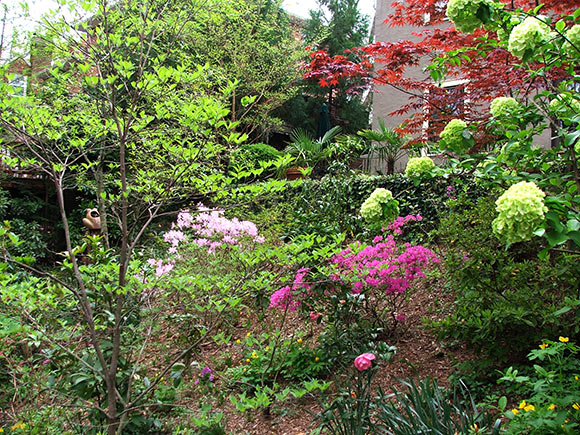Late Spring 2012
Late Spring/ Early Summer Garden Chores
- Fertilizing—The big feed on lawns is usually in the Fall since that's when it's most beneficial. If you have a Southern lawn grass, like Zoysia or Bermuda (or St. Augustine, Centipede or Bahia for more Southern readers), they need to be fed when they are in active growth, which is from April/May until frost. Southern grasses are heavy feeders, so check the fertilizer sack for instructions. Shrubs, groundcovers, landscape plants—I usually only fertilize when I think a plant could use a boost— if a plant looks vigorous and healthy, I don't bother. If I do, I like Woodace, Plant Tone, and Holly Tone. Old-fashioned 5-10-5 and 10-10-10 work well, too. These last two work well in the annual and perennial beds, too. You could also use well-rotted compost or manure for your vegetable and annual beds. For pots, I use Osmocote. It's time-released and lasts the season. On all these, follow the instructions on the sack so you don't burn the plants. If your plants leaves are yellow with the green veins showing, they probably need iron—very common in plants like Azaleas, Gardenias, and other acid-loving plants. Use Ironite or a chelated iron product you can spray on.
- Edging and mulching—If you haven't yet, re-edge your beds with a spade so they are nice and crisp, then mulch with no more than 2-3 inches of hardwood, pine bark or pine straw (needles). Make sure you weed first!!! Hardwood mulch binds together best, so it won't wash as much in hilly areas. The bigger the chip on the pine bark, the more it floats and the harder it is to plant annuals through it (you'll find the trowel stabs the chips!!) Make sure you don't have the mulch up against tree trunks and stems of plants— plants need to breathe and there is a lot of oxygen/carbon dioxide exchange going on where the trunk/stem meets the soil. If you have many layers of old mulch already in place, you may want to rake some of that out, or just very lightly top dress. Studies have shown that a too-deep mulch layer turns into a "false soil" layer; the roots of a plant will grow easily in this layer and not go deeply into the soil. This is not good because that thick mulch layer does not have the nutrients of the soil below. This can result in deficiencies—a common one is the iron deficiency I mentioned above.
- Weed prevention—They were early and they've been fierce this year. We like to use a product called Preen on the beds after we mulch. It's not a cure-all, but it sure does go a long way in helping to prevent weed growth. It's a pre-emergent, so it zaps the weed seeds as they are beginning to emerge. And it will zap any seeds coming up, so not a good idea to use it in areas you are seeding, like vegetable and annual beds. Know this about the herbicide Round-up, too: it is non-selective, so if you spray to control weeds, it will kill EVERYTHING in its path. It's a great product and works through the plant, not the soil, to kill it. Thus, it becomes inactive when it hits the soil, so you can immediately plant in an area sprayed with Round-up. But be careful what you hit when spraying. You don't want to lose a prized plant.
- Planting times—It's perfectly fine to continue planting all trees, shrubs, perennials, vegetables and annuals now, but get them in as soon as possible. It's safe to plant everything outside now.
Houseplants and tropicals—Put them outside for the Summer if you have a spot that is in a little shade so they don't get sunscald. Blooming tropicals can go in full sun; they'll bloom best there.
Next story > The Wilmington Garden
IN THIS ISSUE:

